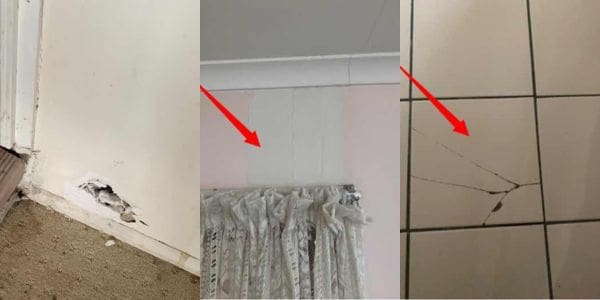Building and Pest Reports: Defect Types and Classifications Explained
Have questions about your building and pest report?
Upon receiving your building and pest report, you may have some questions about the listed building defects. You may be wondering how serious the defects are, when they need repairing and which ones you may be able to negotiate with the vendor.
In this blog, we will take you through what the definitions for building defects are and how they are classified to help you decide what your next steps are and make an informed decision about the property.
Building and pest reports
There are many moving parts to buying a home which can sometimes make the whole process a bit confusing. Building and pest reports are an important piece of this process as they provide a snapshot of the property’s current condition. This ensures you are making an informed decision about the property because you are fully aware of the property’s true condition prior to settlement.
Every report is and must be completed in accordance with Australian Standards
In Australia, every building and pest inspection report must be based on Australian Standards’ AS434.90 – Inspection of buildings general requirements. This means that Australian Standards provide the definitions for any building defects found during a building and pest inspection and a guideline for how the inspectors are to classify them.
What qualifies as a building defect?
Basically, anything that defers from its intended purpose or condition is defined as a building defect. Under Australian Standards, a building defect is, “when there is a fault or deviation from the intended condition of the material, assembly or component”.
A good example of a building defect is a major crack in an internal wall. Either the plaster, something in the wall, or the foundation has deviated from its intended purpose. As there shouldn’t be major cracks in homes that are properly built and stable.
Each inspector will use their expertise and Australian Standard guidelines to determine whether a defect is a safety hazard, major defect or minor defect.
What is a major defect or safety defect?
Put simply, it is a defect that requires repair as soon as possible to avoid further damage, loss of intended use or unsafe conditions.
Example of major defects include:
- Cracked tile in a wet area (Repair is necessary to prevent water from getting under the tile and causing further damage and causes conditions that are favourable for a termite attack)
- Stair treads not secured (This is a safety hazard and immediate repair is required)
- Water ponding around the slab (Water ponding near walls can enter the house and cause damage)
- Ceiling sagging (Repair is required to prevent the ceiling from falling on someone)
- High moisture in the bathroom (Investigation and repair is necessary. Leaking pipes in walls could cause wood rot and high moisture creates favourable conditions for termites)
- Silicone missing around shower base (Repair required immediately to stop water ingress causing damage and wood rot)
As you can see from this list, major does not necessarily equate to a ‘major’ fix, but it is how defects are termed that need to be addressed immediately.
What is a minor defect?
Basically, a minor defect is any defect that is not a major defect. These items are maintenance issues that need addressing but are not necessarily urgent. However, they should still be repaired and scheduled at some time to maintain the property. Some items are listed just to be mindful of and act only if they worsen.
Examples of minor defects include:
- Cracked tile when not located in a wet area
- General ageing
Impact damage - Incomplete patch and paint
- Drummy tiles
In some circumstances, these items might become a major defect, depending on the severity or location of the defect. They may also become a major defect later if left unaddressed.
What is the 'overall condition'?
The overall condition refers to what condition the house is in, compared with other buildings of similar construction and age. It is not the overall condition of the house on its own.
This is a great indication of whether the home has been looked after and whether it has been maintained or updated over the years. On building and pest reports, the inspector will choose from Average, Above Average and Below Average for this comparison.
What does the 'incidence of major and minor defects' mean?
The incidence of major and minor defects refers to whether the number (incidence) of defects listed are “normal” for the building, as compared to other buildings of a similar construction, age and maintenance plans. This is like the above but in this case, it only refers to the major and minor defects, not the overall house. The building inspector will note whether the number of defects is ‘High’, ‘Typical’ or ‘Low’.
It is important to note that this classification is not reflective of the severity of the defects but rather the number of defects in the property. As compared with a buildings of a similar age and construction.
Should all defects at the property be listed in building and pest reports?
In short, no! Under Australian Standards, the building inspection only needs to include defects that are major defects or safety defects. Minor defects are only required to have the ‘Incidence of Minor Defects’ comparison.
At Dedant Building and Pest Inspections, our inspectors do their best to note many minor defects. However, it is not practical to list every single minor defect at each property as there simply isn’t enough time. Likewise, the focus is (and should be) on major defects and safety hazards as these are generally more costly to repair. No home is perfect and for most homes, it would take hours for our inspectors to go through and note every single area that needs maintenance.
The purpose of building and pest reports is to identify any major building defects, safety items and any evidence of termite activity and damage, not maintenance issues.
What kind of defects can you negotiate with vendors?
As professional building and pest inspectors, we cannot advise on which items you may be able to negotiate with vendors. However, as our building and pest reports are completed under Australian Standards, they are recognised by lawyers, real estate agents and conveyancers. This means that should you wish to exit the purchase contract based on the findings of the report, you can do so.
It also means that you may be able to negotiate with the vendor for a lower purchase price or for the vendor to complete the repairs on the major defects. However, this may vary depending on the circumstances of the situation. We recommend liaising with your solicitor or conveyancer before deciding.
Can you advise me not to buy the house?
In short, no. Like the above, we are also unable to comment on whether you should or shouldn’t buy the property. Instead, the role of the building and pest inspector is to provide you with enough information to make an informed decision.
Every situation is unique. Some buyers will buy the property regardless of defects and will happily make the necessary repairs. Others will walk away from the property. As it is all dependent on the severity of the defects, your budget, and whether you have the desire or capacity to complete repairs. For this reason, inspectors cannot reasonably be expected to adequately advise whether the home is a good purchase for someone or not.
Ultimately, it’s your decision whether to buy the property based on the findings of the report. The report is there to help you have enough information about the property to make the decision, based on your current circumstances. Again, we recommend liaising with your financial broker, solicitor or conveyancer for further advice.
Have peace of mind with Dedant Building and Pest Inspections
At Dedant, we pride ourselves on providing ongoing customer care after the inspection. Should you have any further questions, our office team and inspectors are always available and happy to answer your questions.
If you have more questions or would like to know more about building and pest reports, contact us on 07 3807 0122 or via our website.











